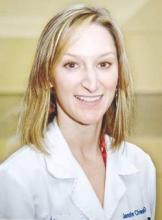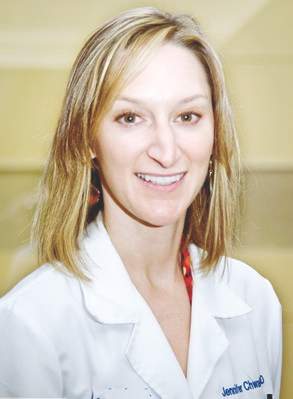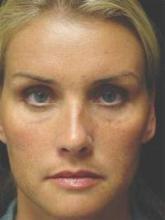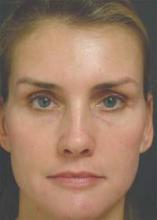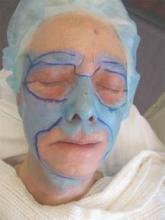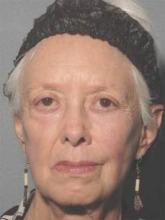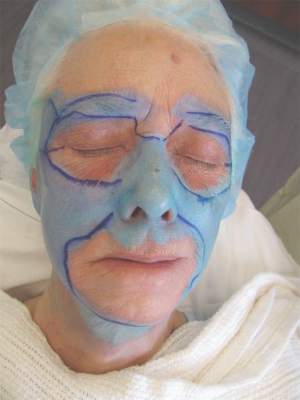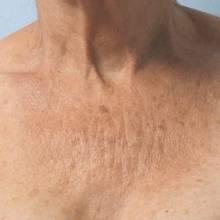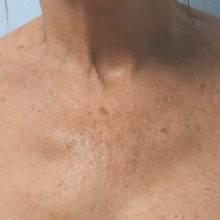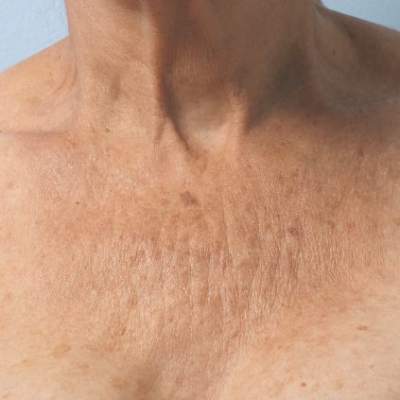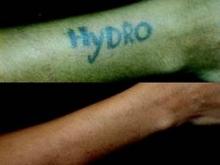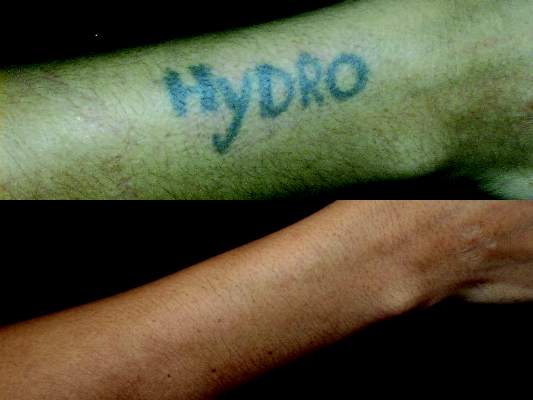User login
American Academy of Cosmetic Surgery (AACS): Annual Scientific Meeting
Acne scars: Match the treatment to the scar type for best results
NEW ORLEANS – Identifying the right treatment for each type of acne scar and using a combination of modalities can yield the best results, according to Dr. Jennifer Chwalek.
Multiple safe, effective, and cost-effective options are available for the treatment of acne scarring, Dr. Chwalek said at the annual meeting of the American Academy of Cosmetic Surgery.
“These techniques are often underutilized, but they’re very easy to put into practice,” Dr. Chwalek said. “With laser resurfacing techniques, they can add to patient improvement and better outcomes.”
Acne is the most common skin disorder in the United States, affecting an estimated 40-50 million people, and by their mid-teens, more than 40% of Americans have had acne accompanied by some scarring, said Dr. Chwalek. The appearance of these scars often worsens and becomes more prominent with aging, she added.
Acne scars are classified by their morphology as ice-pick scars, boxcar scars, and rolling scars. Different categories of scars require different approaches to minimize their appearance and maximize patient satisfaction, said Dr. Chwalek of Mount Sinai Medical Center in New York. Ice pick scars are characterized by small, deep holes in the skin with a wide opening and a narrow base. Boxcar scars present as square or U-shaped depressions in the skin. Scar morphology is a key driver of treatment options; ice pick and boxcar scars can be treated surgically through punch excisions, grafts, and elevation, and through the chemical reconstruction of skin scars technique, Dr. Chwalek said. Skin resurfacing procedures such as chemical peels, dermabrasion, and ablative and nonablative laser resurfacing can also be used to address acne scars. “However, lasers cannot always penetrate deep enough to address deep ice pick and boxcar scars; as a result, outcomes from laser treatments really fall short of our expectations,” she said.
With a punch excision, the acne scar is surgically removed through a punch matching the size of the scar (ideally 1.5-3.5 mm), and the remaining wound is sealed. Punch excision is ideal for deep ice pick scars and narrow, deep boxcar scars (<3 mm), said Dr. Chwalek. “As scars become larger, it is often better to treat with elliptical excision – otherwise you risk contour deformities,” she advised.
The punch elevation method is best for shallow and deep boxcar scars, Dr. Chwalek said. Scars treated with this method should have sharp edges, so the center of the scar can be elevated to the level of the surrounding tissue and reattached by a suture, Steri-Strips thin adhesive strips, or 2-octyl cyanoacrylate glue. Punch elevation brings scars up to the surface level of the skin, making them appear less noticeable, she said.
Punch grafting is an option to treat very deep, large, and more atrophic scars, Dr. Chwalek said. Skin that is not cosmetically sensitive is ideal for this method, and pre- or postauricular skin is typically utilized. However, there is a risk of textural or color mismatch when using this method, Dr. Chwalek noted
For deep acne scars, punch excision, elevation, and grafting are particularly effective when combined with laser resurfacing. “Combining surgical approaches with laser can really result in improvement for the patients,” said Dr. Chwalek.
Histologically, acne scars show a reduction in collagen and elastin. “Chemical reconstruction of skin scars [CROSS] is a technique of applying high concentrations of trichloroacetic acid [TCA] to atrophic ice pick scars to induce inflammation and collagen production,” Dr. Chwalek explained. The CROSS method causes coagulative epidermal necrosis and collagen necrosis in the papillary and upper reticular dermis, resulting in scar remodeling over time.
With the CROSS method, a 50%-100% concentration of TCA should be utilized. The skin should be held taut, and the acid applied directly to the scar using a toothpick or sharp wooden applicator, Dr. Chwalek emphasized. “It’s very important to keep the TCA isolated to the acne scar – if it spills out to the surrounding area, this may result in a potentially larger scar for the patient,” she explained. Higher concentrations of TCA have been shown to be more effective at modifying deeper scars, and typically result in greater patient satisfaction with no significant complications, she added.
Frosting will occur at the site of treatment within 10-15 seconds, crusting will be observed 3 days post treatment, and after a week, the site of treatment will be fully resolved. It is crucial to warn darker-skinned patients of the risk of transient postinflammatory hypopigmentation as a result of the CROSS method, although this resolves within weeks of treatment. “It is also important to make patients aware of downtime associated with CROSS,” she added. “One week after treatment, they may still have crusting.”
“Patients who come to you for acne scarring are really anxious to see improvement,” said Dr. Chwalek, so it is imperative to address patient expectations and to explain that the treatment of acne scars is a gradual process. “It is important to let patients know that it’s going to take multiple treatments to get them to where they want to be,” she added.
Dr. Chwalek reported no relevant financial disclosures.
NEW ORLEANS – Identifying the right treatment for each type of acne scar and using a combination of modalities can yield the best results, according to Dr. Jennifer Chwalek.
Multiple safe, effective, and cost-effective options are available for the treatment of acne scarring, Dr. Chwalek said at the annual meeting of the American Academy of Cosmetic Surgery.
“These techniques are often underutilized, but they’re very easy to put into practice,” Dr. Chwalek said. “With laser resurfacing techniques, they can add to patient improvement and better outcomes.”
Acne is the most common skin disorder in the United States, affecting an estimated 40-50 million people, and by their mid-teens, more than 40% of Americans have had acne accompanied by some scarring, said Dr. Chwalek. The appearance of these scars often worsens and becomes more prominent with aging, she added.
Acne scars are classified by their morphology as ice-pick scars, boxcar scars, and rolling scars. Different categories of scars require different approaches to minimize their appearance and maximize patient satisfaction, said Dr. Chwalek of Mount Sinai Medical Center in New York. Ice pick scars are characterized by small, deep holes in the skin with a wide opening and a narrow base. Boxcar scars present as square or U-shaped depressions in the skin. Scar morphology is a key driver of treatment options; ice pick and boxcar scars can be treated surgically through punch excisions, grafts, and elevation, and through the chemical reconstruction of skin scars technique, Dr. Chwalek said. Skin resurfacing procedures such as chemical peels, dermabrasion, and ablative and nonablative laser resurfacing can also be used to address acne scars. “However, lasers cannot always penetrate deep enough to address deep ice pick and boxcar scars; as a result, outcomes from laser treatments really fall short of our expectations,” she said.
With a punch excision, the acne scar is surgically removed through a punch matching the size of the scar (ideally 1.5-3.5 mm), and the remaining wound is sealed. Punch excision is ideal for deep ice pick scars and narrow, deep boxcar scars (<3 mm), said Dr. Chwalek. “As scars become larger, it is often better to treat with elliptical excision – otherwise you risk contour deformities,” she advised.
The punch elevation method is best for shallow and deep boxcar scars, Dr. Chwalek said. Scars treated with this method should have sharp edges, so the center of the scar can be elevated to the level of the surrounding tissue and reattached by a suture, Steri-Strips thin adhesive strips, or 2-octyl cyanoacrylate glue. Punch elevation brings scars up to the surface level of the skin, making them appear less noticeable, she said.
Punch grafting is an option to treat very deep, large, and more atrophic scars, Dr. Chwalek said. Skin that is not cosmetically sensitive is ideal for this method, and pre- or postauricular skin is typically utilized. However, there is a risk of textural or color mismatch when using this method, Dr. Chwalek noted
For deep acne scars, punch excision, elevation, and grafting are particularly effective when combined with laser resurfacing. “Combining surgical approaches with laser can really result in improvement for the patients,” said Dr. Chwalek.
Histologically, acne scars show a reduction in collagen and elastin. “Chemical reconstruction of skin scars [CROSS] is a technique of applying high concentrations of trichloroacetic acid [TCA] to atrophic ice pick scars to induce inflammation and collagen production,” Dr. Chwalek explained. The CROSS method causes coagulative epidermal necrosis and collagen necrosis in the papillary and upper reticular dermis, resulting in scar remodeling over time.
With the CROSS method, a 50%-100% concentration of TCA should be utilized. The skin should be held taut, and the acid applied directly to the scar using a toothpick or sharp wooden applicator, Dr. Chwalek emphasized. “It’s very important to keep the TCA isolated to the acne scar – if it spills out to the surrounding area, this may result in a potentially larger scar for the patient,” she explained. Higher concentrations of TCA have been shown to be more effective at modifying deeper scars, and typically result in greater patient satisfaction with no significant complications, she added.
Frosting will occur at the site of treatment within 10-15 seconds, crusting will be observed 3 days post treatment, and after a week, the site of treatment will be fully resolved. It is crucial to warn darker-skinned patients of the risk of transient postinflammatory hypopigmentation as a result of the CROSS method, although this resolves within weeks of treatment. “It is also important to make patients aware of downtime associated with CROSS,” she added. “One week after treatment, they may still have crusting.”
“Patients who come to you for acne scarring are really anxious to see improvement,” said Dr. Chwalek, so it is imperative to address patient expectations and to explain that the treatment of acne scars is a gradual process. “It is important to let patients know that it’s going to take multiple treatments to get them to where they want to be,” she added.
Dr. Chwalek reported no relevant financial disclosures.
NEW ORLEANS – Identifying the right treatment for each type of acne scar and using a combination of modalities can yield the best results, according to Dr. Jennifer Chwalek.
Multiple safe, effective, and cost-effective options are available for the treatment of acne scarring, Dr. Chwalek said at the annual meeting of the American Academy of Cosmetic Surgery.
“These techniques are often underutilized, but they’re very easy to put into practice,” Dr. Chwalek said. “With laser resurfacing techniques, they can add to patient improvement and better outcomes.”
Acne is the most common skin disorder in the United States, affecting an estimated 40-50 million people, and by their mid-teens, more than 40% of Americans have had acne accompanied by some scarring, said Dr. Chwalek. The appearance of these scars often worsens and becomes more prominent with aging, she added.
Acne scars are classified by their morphology as ice-pick scars, boxcar scars, and rolling scars. Different categories of scars require different approaches to minimize their appearance and maximize patient satisfaction, said Dr. Chwalek of Mount Sinai Medical Center in New York. Ice pick scars are characterized by small, deep holes in the skin with a wide opening and a narrow base. Boxcar scars present as square or U-shaped depressions in the skin. Scar morphology is a key driver of treatment options; ice pick and boxcar scars can be treated surgically through punch excisions, grafts, and elevation, and through the chemical reconstruction of skin scars technique, Dr. Chwalek said. Skin resurfacing procedures such as chemical peels, dermabrasion, and ablative and nonablative laser resurfacing can also be used to address acne scars. “However, lasers cannot always penetrate deep enough to address deep ice pick and boxcar scars; as a result, outcomes from laser treatments really fall short of our expectations,” she said.
With a punch excision, the acne scar is surgically removed through a punch matching the size of the scar (ideally 1.5-3.5 mm), and the remaining wound is sealed. Punch excision is ideal for deep ice pick scars and narrow, deep boxcar scars (<3 mm), said Dr. Chwalek. “As scars become larger, it is often better to treat with elliptical excision – otherwise you risk contour deformities,” she advised.
The punch elevation method is best for shallow and deep boxcar scars, Dr. Chwalek said. Scars treated with this method should have sharp edges, so the center of the scar can be elevated to the level of the surrounding tissue and reattached by a suture, Steri-Strips thin adhesive strips, or 2-octyl cyanoacrylate glue. Punch elevation brings scars up to the surface level of the skin, making them appear less noticeable, she said.
Punch grafting is an option to treat very deep, large, and more atrophic scars, Dr. Chwalek said. Skin that is not cosmetically sensitive is ideal for this method, and pre- or postauricular skin is typically utilized. However, there is a risk of textural or color mismatch when using this method, Dr. Chwalek noted
For deep acne scars, punch excision, elevation, and grafting are particularly effective when combined with laser resurfacing. “Combining surgical approaches with laser can really result in improvement for the patients,” said Dr. Chwalek.
Histologically, acne scars show a reduction in collagen and elastin. “Chemical reconstruction of skin scars [CROSS] is a technique of applying high concentrations of trichloroacetic acid [TCA] to atrophic ice pick scars to induce inflammation and collagen production,” Dr. Chwalek explained. The CROSS method causes coagulative epidermal necrosis and collagen necrosis in the papillary and upper reticular dermis, resulting in scar remodeling over time.
With the CROSS method, a 50%-100% concentration of TCA should be utilized. The skin should be held taut, and the acid applied directly to the scar using a toothpick or sharp wooden applicator, Dr. Chwalek emphasized. “It’s very important to keep the TCA isolated to the acne scar – if it spills out to the surrounding area, this may result in a potentially larger scar for the patient,” she explained. Higher concentrations of TCA have been shown to be more effective at modifying deeper scars, and typically result in greater patient satisfaction with no significant complications, she added.
Frosting will occur at the site of treatment within 10-15 seconds, crusting will be observed 3 days post treatment, and after a week, the site of treatment will be fully resolved. It is crucial to warn darker-skinned patients of the risk of transient postinflammatory hypopigmentation as a result of the CROSS method, although this resolves within weeks of treatment. “It is also important to make patients aware of downtime associated with CROSS,” she added. “One week after treatment, they may still have crusting.”
“Patients who come to you for acne scarring are really anxious to see improvement,” said Dr. Chwalek, so it is imperative to address patient expectations and to explain that the treatment of acne scars is a gradual process. “It is important to let patients know that it’s going to take multiple treatments to get them to where they want to be,” she added.
Dr. Chwalek reported no relevant financial disclosures.
AT THE AACS ANNUAL MEETING
Screening candidates for laser resurfacing procedures
NEW ORLEANS – Patients must be psychologically stable to tolerate laser resurfacing procedures, according to Dr. Ronald L. Moy, a board-certified cosmetic surgeon and dermatologist.
“It’s difficult for patients to go through a laser resurfacing, because the skin on their face will look bad for 3 to 4 days, compared to a facelift where things are hidden behind an ear, sutures are neat, and there is very little bleeding,” Dr. Moy said at the annual meeting of the American Academy of Cosmetic Surgery. “Out of all the procedures that we do, it is perhaps most important to screen patients prior to resurfacing procedures.”
It is important to get to know patients and to become familiar with issues that bother them about their appearance. Patient concerns such as skin wrinkling, lax brows, asymmetry, and brow positioning should be discussed. “We as physicians tend to lecture people, but the consultation is the time to get to know them – this is the time you might find out how fragile someone is,” said Dr. Moy, who is based in Beverly Hills, Calif.
Having another person in the room might be beneficial, and the use of a mirror can aid in getting patients to talk about skin concerns such as wrinkle lines. “What really bothers them might not be what really bothers us,” he advised. “So these tools can be valuable in addressing the issues that arise from a communication gap.”
Stretching the skin, particularly around the mouth, can simulate the outcome of some laser resurfacing procedures. Simulation programs and before/after photographs also can be used to manage patients’ expectations. It is important to also show photos of results that are not ideal, Dr. Moy advised.
“It’s always better to undertreat and do the procedure again, and to even do a free treatment if you have to, than it is to overtreat and give the patient a scar.” Showing a photograph of your best work might sell the procedure to a patient, but it is important to prepare patients by showing them an average result as well, he added.
Having the patient lie back can simulate blepharoplasty by causing the fat pads to fall backward and flatten. This method is not ideal to simulate the results of laser resurfacing but can be beneficial when procedures are being combined. “In truth, laser resurfacing is usually done with another procedure,” Dr. Moy said. “In my practice, the most common scenario is laser resurfacing and an isolated neck lift, as the popularity of facelifts seems to be decreasing.”
“After you listen to the patient, it’s time to explain to them what the process is going to be like and to warn them of the risk of depression on day 2 or 3 after a resurfacing procedure,” Dr. Moy recommended.
Patient medical history to consider includes any physical or psychological diagnosis, history of medication (over-the-counter, prescription, and herbal), allergies, history of scarring, tolerance for local anesthesia, recent sun exposure (natural or artificial), recent resurfacing procedures (laser, chemical, and/or mechanical), history of herpes simplex (cold sore), current skin care regimen, radiation exposure, and history of tattoo in the area to be treated.
History of isotretinoin (Accutane) also should be discussed. Evidence in the literature of isotretinoin suggests use causing scarring after a resurfacing procedure, so it might be best to advise patients to discontinue its use for several months before resurfacing, he advised.
Certain patients should be ruled out when it comes to laser resurfacing, Dr. Moy stressed. These patients include those who are psychologically unstable, have a history of money troubles, and threaten lawsuits. In addition, avoid rude, unfriendly patients who talk negatively about other surgeons. Patients who do not smile or make eye contact also might be poor candidates, although that isn’t always an accurate assumption, he added.
Other patients to avoid include those who do not listen and only talk, and patients who “know more” than the surgeon. “Often, patients will try to lecture the surgeon based on what they’ve researched on the Internet,” he said. Additionally, those who request surgeries normally reserved for older patients, patients with unrealistic expectations, and those seeking to have surgery for the wrong reasons, such as saving a marriage, should be avoided, Dr. Moy said.
Social factors to consider include a patient’s work and living situation, hygiene, and history of medications, particularly antidepressants. But perhaps most paramount is a patient’s ability to cope, Dr. Moy said. “In the end, screening a new candidate for a laser resurfacing procedure is really about getting to know them, and also using and trusting your gut instinct,” he added.
Dr. Moy reported no relevant financial disclosures.
NEW ORLEANS – Patients must be psychologically stable to tolerate laser resurfacing procedures, according to Dr. Ronald L. Moy, a board-certified cosmetic surgeon and dermatologist.
“It’s difficult for patients to go through a laser resurfacing, because the skin on their face will look bad for 3 to 4 days, compared to a facelift where things are hidden behind an ear, sutures are neat, and there is very little bleeding,” Dr. Moy said at the annual meeting of the American Academy of Cosmetic Surgery. “Out of all the procedures that we do, it is perhaps most important to screen patients prior to resurfacing procedures.”
It is important to get to know patients and to become familiar with issues that bother them about their appearance. Patient concerns such as skin wrinkling, lax brows, asymmetry, and brow positioning should be discussed. “We as physicians tend to lecture people, but the consultation is the time to get to know them – this is the time you might find out how fragile someone is,” said Dr. Moy, who is based in Beverly Hills, Calif.
Having another person in the room might be beneficial, and the use of a mirror can aid in getting patients to talk about skin concerns such as wrinkle lines. “What really bothers them might not be what really bothers us,” he advised. “So these tools can be valuable in addressing the issues that arise from a communication gap.”
Stretching the skin, particularly around the mouth, can simulate the outcome of some laser resurfacing procedures. Simulation programs and before/after photographs also can be used to manage patients’ expectations. It is important to also show photos of results that are not ideal, Dr. Moy advised.
“It’s always better to undertreat and do the procedure again, and to even do a free treatment if you have to, than it is to overtreat and give the patient a scar.” Showing a photograph of your best work might sell the procedure to a patient, but it is important to prepare patients by showing them an average result as well, he added.
Having the patient lie back can simulate blepharoplasty by causing the fat pads to fall backward and flatten. This method is not ideal to simulate the results of laser resurfacing but can be beneficial when procedures are being combined. “In truth, laser resurfacing is usually done with another procedure,” Dr. Moy said. “In my practice, the most common scenario is laser resurfacing and an isolated neck lift, as the popularity of facelifts seems to be decreasing.”
“After you listen to the patient, it’s time to explain to them what the process is going to be like and to warn them of the risk of depression on day 2 or 3 after a resurfacing procedure,” Dr. Moy recommended.
Patient medical history to consider includes any physical or psychological diagnosis, history of medication (over-the-counter, prescription, and herbal), allergies, history of scarring, tolerance for local anesthesia, recent sun exposure (natural or artificial), recent resurfacing procedures (laser, chemical, and/or mechanical), history of herpes simplex (cold sore), current skin care regimen, radiation exposure, and history of tattoo in the area to be treated.
History of isotretinoin (Accutane) also should be discussed. Evidence in the literature of isotretinoin suggests use causing scarring after a resurfacing procedure, so it might be best to advise patients to discontinue its use for several months before resurfacing, he advised.
Certain patients should be ruled out when it comes to laser resurfacing, Dr. Moy stressed. These patients include those who are psychologically unstable, have a history of money troubles, and threaten lawsuits. In addition, avoid rude, unfriendly patients who talk negatively about other surgeons. Patients who do not smile or make eye contact also might be poor candidates, although that isn’t always an accurate assumption, he added.
Other patients to avoid include those who do not listen and only talk, and patients who “know more” than the surgeon. “Often, patients will try to lecture the surgeon based on what they’ve researched on the Internet,” he said. Additionally, those who request surgeries normally reserved for older patients, patients with unrealistic expectations, and those seeking to have surgery for the wrong reasons, such as saving a marriage, should be avoided, Dr. Moy said.
Social factors to consider include a patient’s work and living situation, hygiene, and history of medications, particularly antidepressants. But perhaps most paramount is a patient’s ability to cope, Dr. Moy said. “In the end, screening a new candidate for a laser resurfacing procedure is really about getting to know them, and also using and trusting your gut instinct,” he added.
Dr. Moy reported no relevant financial disclosures.
NEW ORLEANS – Patients must be psychologically stable to tolerate laser resurfacing procedures, according to Dr. Ronald L. Moy, a board-certified cosmetic surgeon and dermatologist.
“It’s difficult for patients to go through a laser resurfacing, because the skin on their face will look bad for 3 to 4 days, compared to a facelift where things are hidden behind an ear, sutures are neat, and there is very little bleeding,” Dr. Moy said at the annual meeting of the American Academy of Cosmetic Surgery. “Out of all the procedures that we do, it is perhaps most important to screen patients prior to resurfacing procedures.”
It is important to get to know patients and to become familiar with issues that bother them about their appearance. Patient concerns such as skin wrinkling, lax brows, asymmetry, and brow positioning should be discussed. “We as physicians tend to lecture people, but the consultation is the time to get to know them – this is the time you might find out how fragile someone is,” said Dr. Moy, who is based in Beverly Hills, Calif.
Having another person in the room might be beneficial, and the use of a mirror can aid in getting patients to talk about skin concerns such as wrinkle lines. “What really bothers them might not be what really bothers us,” he advised. “So these tools can be valuable in addressing the issues that arise from a communication gap.”
Stretching the skin, particularly around the mouth, can simulate the outcome of some laser resurfacing procedures. Simulation programs and before/after photographs also can be used to manage patients’ expectations. It is important to also show photos of results that are not ideal, Dr. Moy advised.
“It’s always better to undertreat and do the procedure again, and to even do a free treatment if you have to, than it is to overtreat and give the patient a scar.” Showing a photograph of your best work might sell the procedure to a patient, but it is important to prepare patients by showing them an average result as well, he added.
Having the patient lie back can simulate blepharoplasty by causing the fat pads to fall backward and flatten. This method is not ideal to simulate the results of laser resurfacing but can be beneficial when procedures are being combined. “In truth, laser resurfacing is usually done with another procedure,” Dr. Moy said. “In my practice, the most common scenario is laser resurfacing and an isolated neck lift, as the popularity of facelifts seems to be decreasing.”
“After you listen to the patient, it’s time to explain to them what the process is going to be like and to warn them of the risk of depression on day 2 or 3 after a resurfacing procedure,” Dr. Moy recommended.
Patient medical history to consider includes any physical or psychological diagnosis, history of medication (over-the-counter, prescription, and herbal), allergies, history of scarring, tolerance for local anesthesia, recent sun exposure (natural or artificial), recent resurfacing procedures (laser, chemical, and/or mechanical), history of herpes simplex (cold sore), current skin care regimen, radiation exposure, and history of tattoo in the area to be treated.
History of isotretinoin (Accutane) also should be discussed. Evidence in the literature of isotretinoin suggests use causing scarring after a resurfacing procedure, so it might be best to advise patients to discontinue its use for several months before resurfacing, he advised.
Certain patients should be ruled out when it comes to laser resurfacing, Dr. Moy stressed. These patients include those who are psychologically unstable, have a history of money troubles, and threaten lawsuits. In addition, avoid rude, unfriendly patients who talk negatively about other surgeons. Patients who do not smile or make eye contact also might be poor candidates, although that isn’t always an accurate assumption, he added.
Other patients to avoid include those who do not listen and only talk, and patients who “know more” than the surgeon. “Often, patients will try to lecture the surgeon based on what they’ve researched on the Internet,” he said. Additionally, those who request surgeries normally reserved for older patients, patients with unrealistic expectations, and those seeking to have surgery for the wrong reasons, such as saving a marriage, should be avoided, Dr. Moy said.
Social factors to consider include a patient’s work and living situation, hygiene, and history of medications, particularly antidepressants. But perhaps most paramount is a patient’s ability to cope, Dr. Moy said. “In the end, screening a new candidate for a laser resurfacing procedure is really about getting to know them, and also using and trusting your gut instinct,” he added.
Dr. Moy reported no relevant financial disclosures.
EXPERT ANALYSIS AT THE AACS ANNUAL MEETING
Treatment for dark lower eyelid circles
NEW ORLEANS – Addressing the problem of dark lower eyelid circles may require the use of multiple modalities, but defining the cause is the first step toward effective treatment, Dr. Joel E. Kopelman said at the annual meeting of the American Academy of Cosmetic Surgery.
Lower eyelid dark circles affect patients of all ages and races and often create a fatigued and sad appearance. Loss of volume in the eyelid, midfacial, and orbital areas; superficial and deep pigmentation; thin, translucent skin with a paucity of fat between the skin and orbicularis muscle; and shadowing from herniated or pseudo-herniated protruding fat all might contribute to the appearance of dark lower eyelid circles, he said.
By first identifying the source of the dark circles, practitioners can make informed decisions about the correct course of treatment. “Some are easier to treat than others, but each one presents its own challenge,” said Dr. Kopelman, an ophthalmic plastic surgeon in Ridgewood, N.J.
Correcting the appearance of lower eyelid circles entails the use of one or more modalities, depending upon the etiology of the problem. “Volume restoration alone doesn’t address the entire problem, nor does it maximize the opportunity for improvement,” Dr. Kopelman said. “The issue of pigmentation is one that we often overlook.”
He recommends a primary skin evaluation with the use of a Wood’s lamp, which will assess the depth of pigmentation and intensify superficial pigment. If skin hyperpigmentation is the cause of the dark circles, lightening the skin with topical phenolic or nonphenolic depigmenting agents, and/or laser therapy, might help to significantly reduce lower eyelid skin pigmentation.
Hydroquinone (HQ) and Kojic acid are considered the strongest phenolic bleaching agents, he noted. Topical application of these compounds should start at twice a day for 4-6 weeks, but long-term use of these treatments can lead to irritation, so treatment should be spread out and/or lessened as needed.
Nonphenolic bleaching compounds also can be used to treat pigmentation. “Over time, these compounds can yield nice blanching without the toxicity of HQ, but you have to use them for several months to get the kind of results you want,” he added.
Melanozyme (lignin peroxidase) is another treatment effective at reducing pigment. “This is sometimes used in conjunction with hydroquinone right away, since Melanozyme breaks down existing melanin rather than trying to prevent melanin from forming,” Dr. Kopelman stated. There is no delay in activation with the use of Melanozyme, as opposed to the use of HQ, which usually takes several weeks to have a suppressive effect on pigment generating cells. He recommends an initial therapy regimen of a phenolic bleaching agent with or without the use of Melanozyme, and the substitution of nonphenolic compounds in a long-term therapy regimen.
Fractionated lasers also can be used to apply these drugs, he reported. The protocol involves creating a channel of predetermined depth and density, which allows for immediate application and penetration of topical drugs. Dr. Kopelman recommends applying medication immediately after delivering the fractionated laser treatment to the pigmented area, which will allow the medicine to better penetrate into the deeper layers of skin.
Chemical peels and laser resurfacing can be used as a secondary level of therapy, but “these can induce postinflammatory hyperpigmentation, so I’m very cautious about using anything that delivers heat or strong chemicals, as they can make things worse,” he warned. Laser treatment can be used as a tertiary level of treatment to disrupt melanin production. “But using lasers around the eyelids can be dangerous, so you have to be very cautious,” he added.
Patients must understand that the process of treating dark undereye circles takes time, and realistic expectations are a central part of the process, Dr. Kopelman emphasized. Often, multiple modalities are necessary to achieve an improvement, so patients must commit to long-term treatment, be compliant with applying medication on a daily basis, avoid sun exposure, and wear polarized sunglasses and sunblocks to prevent the sun from stimulating melanin production and achieve improved aesthetic outcomes.
Dr. Kopelman reported no relevant financial disclosures.
NEW ORLEANS – Addressing the problem of dark lower eyelid circles may require the use of multiple modalities, but defining the cause is the first step toward effective treatment, Dr. Joel E. Kopelman said at the annual meeting of the American Academy of Cosmetic Surgery.
Lower eyelid dark circles affect patients of all ages and races and often create a fatigued and sad appearance. Loss of volume in the eyelid, midfacial, and orbital areas; superficial and deep pigmentation; thin, translucent skin with a paucity of fat between the skin and orbicularis muscle; and shadowing from herniated or pseudo-herniated protruding fat all might contribute to the appearance of dark lower eyelid circles, he said.
By first identifying the source of the dark circles, practitioners can make informed decisions about the correct course of treatment. “Some are easier to treat than others, but each one presents its own challenge,” said Dr. Kopelman, an ophthalmic plastic surgeon in Ridgewood, N.J.
Correcting the appearance of lower eyelid circles entails the use of one or more modalities, depending upon the etiology of the problem. “Volume restoration alone doesn’t address the entire problem, nor does it maximize the opportunity for improvement,” Dr. Kopelman said. “The issue of pigmentation is one that we often overlook.”
He recommends a primary skin evaluation with the use of a Wood’s lamp, which will assess the depth of pigmentation and intensify superficial pigment. If skin hyperpigmentation is the cause of the dark circles, lightening the skin with topical phenolic or nonphenolic depigmenting agents, and/or laser therapy, might help to significantly reduce lower eyelid skin pigmentation.
Hydroquinone (HQ) and Kojic acid are considered the strongest phenolic bleaching agents, he noted. Topical application of these compounds should start at twice a day for 4-6 weeks, but long-term use of these treatments can lead to irritation, so treatment should be spread out and/or lessened as needed.
Nonphenolic bleaching compounds also can be used to treat pigmentation. “Over time, these compounds can yield nice blanching without the toxicity of HQ, but you have to use them for several months to get the kind of results you want,” he added.
Melanozyme (lignin peroxidase) is another treatment effective at reducing pigment. “This is sometimes used in conjunction with hydroquinone right away, since Melanozyme breaks down existing melanin rather than trying to prevent melanin from forming,” Dr. Kopelman stated. There is no delay in activation with the use of Melanozyme, as opposed to the use of HQ, which usually takes several weeks to have a suppressive effect on pigment generating cells. He recommends an initial therapy regimen of a phenolic bleaching agent with or without the use of Melanozyme, and the substitution of nonphenolic compounds in a long-term therapy regimen.
Fractionated lasers also can be used to apply these drugs, he reported. The protocol involves creating a channel of predetermined depth and density, which allows for immediate application and penetration of topical drugs. Dr. Kopelman recommends applying medication immediately after delivering the fractionated laser treatment to the pigmented area, which will allow the medicine to better penetrate into the deeper layers of skin.
Chemical peels and laser resurfacing can be used as a secondary level of therapy, but “these can induce postinflammatory hyperpigmentation, so I’m very cautious about using anything that delivers heat or strong chemicals, as they can make things worse,” he warned. Laser treatment can be used as a tertiary level of treatment to disrupt melanin production. “But using lasers around the eyelids can be dangerous, so you have to be very cautious,” he added.
Patients must understand that the process of treating dark undereye circles takes time, and realistic expectations are a central part of the process, Dr. Kopelman emphasized. Often, multiple modalities are necessary to achieve an improvement, so patients must commit to long-term treatment, be compliant with applying medication on a daily basis, avoid sun exposure, and wear polarized sunglasses and sunblocks to prevent the sun from stimulating melanin production and achieve improved aesthetic outcomes.
Dr. Kopelman reported no relevant financial disclosures.
NEW ORLEANS – Addressing the problem of dark lower eyelid circles may require the use of multiple modalities, but defining the cause is the first step toward effective treatment, Dr. Joel E. Kopelman said at the annual meeting of the American Academy of Cosmetic Surgery.
Lower eyelid dark circles affect patients of all ages and races and often create a fatigued and sad appearance. Loss of volume in the eyelid, midfacial, and orbital areas; superficial and deep pigmentation; thin, translucent skin with a paucity of fat between the skin and orbicularis muscle; and shadowing from herniated or pseudo-herniated protruding fat all might contribute to the appearance of dark lower eyelid circles, he said.
By first identifying the source of the dark circles, practitioners can make informed decisions about the correct course of treatment. “Some are easier to treat than others, but each one presents its own challenge,” said Dr. Kopelman, an ophthalmic plastic surgeon in Ridgewood, N.J.
Correcting the appearance of lower eyelid circles entails the use of one or more modalities, depending upon the etiology of the problem. “Volume restoration alone doesn’t address the entire problem, nor does it maximize the opportunity for improvement,” Dr. Kopelman said. “The issue of pigmentation is one that we often overlook.”
He recommends a primary skin evaluation with the use of a Wood’s lamp, which will assess the depth of pigmentation and intensify superficial pigment. If skin hyperpigmentation is the cause of the dark circles, lightening the skin with topical phenolic or nonphenolic depigmenting agents, and/or laser therapy, might help to significantly reduce lower eyelid skin pigmentation.
Hydroquinone (HQ) and Kojic acid are considered the strongest phenolic bleaching agents, he noted. Topical application of these compounds should start at twice a day for 4-6 weeks, but long-term use of these treatments can lead to irritation, so treatment should be spread out and/or lessened as needed.
Nonphenolic bleaching compounds also can be used to treat pigmentation. “Over time, these compounds can yield nice blanching without the toxicity of HQ, but you have to use them for several months to get the kind of results you want,” he added.
Melanozyme (lignin peroxidase) is another treatment effective at reducing pigment. “This is sometimes used in conjunction with hydroquinone right away, since Melanozyme breaks down existing melanin rather than trying to prevent melanin from forming,” Dr. Kopelman stated. There is no delay in activation with the use of Melanozyme, as opposed to the use of HQ, which usually takes several weeks to have a suppressive effect on pigment generating cells. He recommends an initial therapy regimen of a phenolic bleaching agent with or without the use of Melanozyme, and the substitution of nonphenolic compounds in a long-term therapy regimen.
Fractionated lasers also can be used to apply these drugs, he reported. The protocol involves creating a channel of predetermined depth and density, which allows for immediate application and penetration of topical drugs. Dr. Kopelman recommends applying medication immediately after delivering the fractionated laser treatment to the pigmented area, which will allow the medicine to better penetrate into the deeper layers of skin.
Chemical peels and laser resurfacing can be used as a secondary level of therapy, but “these can induce postinflammatory hyperpigmentation, so I’m very cautious about using anything that delivers heat or strong chemicals, as they can make things worse,” he warned. Laser treatment can be used as a tertiary level of treatment to disrupt melanin production. “But using lasers around the eyelids can be dangerous, so you have to be very cautious,” he added.
Patients must understand that the process of treating dark undereye circles takes time, and realistic expectations are a central part of the process, Dr. Kopelman emphasized. Often, multiple modalities are necessary to achieve an improvement, so patients must commit to long-term treatment, be compliant with applying medication on a daily basis, avoid sun exposure, and wear polarized sunglasses and sunblocks to prevent the sun from stimulating melanin production and achieve improved aesthetic outcomes.
Dr. Kopelman reported no relevant financial disclosures.
EXPERT ANALYSIS FROM THE AACS ANNUAL MEETING
Patient preparation maximizes resurfacing results
NEW ORLEANS – Knowledge of skin anatomy and methods of proper pretreatment will enhance and extend the results of skin-resurfacing modalities, according to Dr. Suzan Obagi.
Skin resurfacing procedures continue to grow in popularity, and newer resurfacing modalities with less recovery time are regularly being introduced, Dr. Obagi said at the annual meeting of the American Academy of Cosmetic Surgery.
“Managing the skin properly by appropriately evaluating and treating it before, during, and after a skin resurfacing procedure will allow us to expand the base of patients we can treat safely, improve and maximize their results, and reduce complications,” she added.
The most common patient concerns are acne, wrinkles, pores, rosacea, facial redness, sensitive skin, and discoloration, said Dr. Obagi of the University of Pittsburgh.
“We hear about these issues all the time, so we need to know how to properly address them,” she noted. Discuss a range of procedures and the downtime associated with each modality when advising patients. “What patients do at home is equally – if not more – important than what is done in the office,” she stressed. “This puts some of the responsibility on them [patients]; we can only fix so much, but they have to be partners with us in this process.”
Aesthetic skin concerns can be treated with chemical peels, lasers, fillers, and skin-tightening procedures, but anyone performing surgery without first preparing the patient’s skin is doing the patient a disservice, Dr. Obagi stated.
Topical agents should be considered prior to other treatments, she advised. “A patient with excessive wrinkles will not achieve the desired result through a face-lift alone; I want to fix their skin first, and then do the face-lift if needed,” she noted. Similarly, skin problems such as rosacea and acne must be addressed before considering resurfacing modalities, as resurfacing skin that is actively inflamed will only exacerbate the issue, she said.
To maximize results from a skin-resurfacing modality, skin must be healthy before it is treated. “If you laser away just one brown spot, you’ll have a healthy spot of skin surrounded by a sea of sun damage,” said Dr. Obagi. Healthy skin heals faster and scars are less noticeable when sun damage is primarily addressed. This process serves as a test of patient compliance with instructions, she added.
The importance of topical agents in a preoperative skin care regimen cannot be overstated, she said. A retinoid should always be used to activate and stimulate keratinocytes and fibroblasts, and hydroquinone should be used to stimulate melanocytes. The use of hydroquinone is controversial, but claims regarding its carcinogenic properties have not been supported in the literature, said Dr. Obagi. “If you want to see results, become comfortable speaking to the safety of hydroquinone and using it properly in your patients,” she added. Mineral-based sunblock should take the place of a daily moisturizer, and a product containing zinc or titanium is recommended. “Many of us work under fluorescent light; even the visible spectrum of light interacts with tissue and causes some of the aging we’re seeing, and chemical sunscreens don’t touch that spectrum,” she stated. Finally, supportive topical agents such as AHAs, benzoyl peroxide, and astringents can be added as needed to a topical skin care regimen depending on a patient’s skin concerns.
Pre-resurfacing goals include controlling acne and rosacea, testing compliance, enhancing wound healing, and controlling pigment production. When all of these issues are addressed prior to resurfacing, results are enhanced. “Always do a skin conditioning treatment, as this makes results more dramatic,” said Dr. Obagi. “I usually do a pre-resurfacing regimen for 6 weeks on a lighter-skinned patient; on a patient with darker skin I continue the regimen for about 12 weeks before I feel I can safely treat them,” she said.
Resurfacing treatments must be tailored to differing levels of the skin for different conditions, Dr. Obagi noted. Sun damage resides very superficially in the epidermis, wrinkles and scars can reside superficially or deeper, and acne and rosacea involve deeper layers of the skin. Some treatments will not go deep enough in the skin to address certain problems, so it is crucial to address treatment depths to where the problem actually resides. “Although new lasers are constantly introduced, one thing that has remained stable is skin cells; we know we can only target certain ones,” she added.
Cellular targets for skin health restoration in the keratinocytes involve normalizing turnover and improving atypia; in the melanocytes, the targets involve decreasing pigment production and enhancing melanin distribution. Deeper in the dermis, cellular targets for skin health in the fibroblasts include increasing collagen, elastin and glycosaminoglycans (GAGs). “We want to take these cells and really stimulate and control them at every level, so we can make patients heal the way we want them to post procedurally,” explained Dr. Obagi.
For best results, postresurfacing goals should involve resuming control of acne and rosacea, monitoring for complications such as infections, and enhancing wound healing through such modalities as steroids, antibiotics, or low-level lasers when appropriate. “However, the most crucial postresurfacing goal is controlling pigmentation. Don’t wait for hyperpigmentation to occur; it is much harder to treat than it is to prevent,” Dr. Obagi emphasized.
Establishing a proper skin care regimen prior to a procedure is vital in combating aging, and will in turn produce better and longer-lasting procedure results with fewer complications, said Dr. Obagi. Further, communicating with patients and involving them in their own skin care establishes trust and confidence. These patients will be happier with their surgical results, will report for regular follow-ups, and will serve as sources of referral. “If you deliver results before you even get to the procedure, the patient will trust you implicitly,” Dr. Obagi said.
Dr. Obagi reported serving on the scientific advisory board for Valeant Pharmaceuticals.
NEW ORLEANS – Knowledge of skin anatomy and methods of proper pretreatment will enhance and extend the results of skin-resurfacing modalities, according to Dr. Suzan Obagi.
Skin resurfacing procedures continue to grow in popularity, and newer resurfacing modalities with less recovery time are regularly being introduced, Dr. Obagi said at the annual meeting of the American Academy of Cosmetic Surgery.
“Managing the skin properly by appropriately evaluating and treating it before, during, and after a skin resurfacing procedure will allow us to expand the base of patients we can treat safely, improve and maximize their results, and reduce complications,” she added.
The most common patient concerns are acne, wrinkles, pores, rosacea, facial redness, sensitive skin, and discoloration, said Dr. Obagi of the University of Pittsburgh.
“We hear about these issues all the time, so we need to know how to properly address them,” she noted. Discuss a range of procedures and the downtime associated with each modality when advising patients. “What patients do at home is equally – if not more – important than what is done in the office,” she stressed. “This puts some of the responsibility on them [patients]; we can only fix so much, but they have to be partners with us in this process.”
Aesthetic skin concerns can be treated with chemical peels, lasers, fillers, and skin-tightening procedures, but anyone performing surgery without first preparing the patient’s skin is doing the patient a disservice, Dr. Obagi stated.
Topical agents should be considered prior to other treatments, she advised. “A patient with excessive wrinkles will not achieve the desired result through a face-lift alone; I want to fix their skin first, and then do the face-lift if needed,” she noted. Similarly, skin problems such as rosacea and acne must be addressed before considering resurfacing modalities, as resurfacing skin that is actively inflamed will only exacerbate the issue, she said.
To maximize results from a skin-resurfacing modality, skin must be healthy before it is treated. “If you laser away just one brown spot, you’ll have a healthy spot of skin surrounded by a sea of sun damage,” said Dr. Obagi. Healthy skin heals faster and scars are less noticeable when sun damage is primarily addressed. This process serves as a test of patient compliance with instructions, she added.
The importance of topical agents in a preoperative skin care regimen cannot be overstated, she said. A retinoid should always be used to activate and stimulate keratinocytes and fibroblasts, and hydroquinone should be used to stimulate melanocytes. The use of hydroquinone is controversial, but claims regarding its carcinogenic properties have not been supported in the literature, said Dr. Obagi. “If you want to see results, become comfortable speaking to the safety of hydroquinone and using it properly in your patients,” she added. Mineral-based sunblock should take the place of a daily moisturizer, and a product containing zinc or titanium is recommended. “Many of us work under fluorescent light; even the visible spectrum of light interacts with tissue and causes some of the aging we’re seeing, and chemical sunscreens don’t touch that spectrum,” she stated. Finally, supportive topical agents such as AHAs, benzoyl peroxide, and astringents can be added as needed to a topical skin care regimen depending on a patient’s skin concerns.
Pre-resurfacing goals include controlling acne and rosacea, testing compliance, enhancing wound healing, and controlling pigment production. When all of these issues are addressed prior to resurfacing, results are enhanced. “Always do a skin conditioning treatment, as this makes results more dramatic,” said Dr. Obagi. “I usually do a pre-resurfacing regimen for 6 weeks on a lighter-skinned patient; on a patient with darker skin I continue the regimen for about 12 weeks before I feel I can safely treat them,” she said.
Resurfacing treatments must be tailored to differing levels of the skin for different conditions, Dr. Obagi noted. Sun damage resides very superficially in the epidermis, wrinkles and scars can reside superficially or deeper, and acne and rosacea involve deeper layers of the skin. Some treatments will not go deep enough in the skin to address certain problems, so it is crucial to address treatment depths to where the problem actually resides. “Although new lasers are constantly introduced, one thing that has remained stable is skin cells; we know we can only target certain ones,” she added.
Cellular targets for skin health restoration in the keratinocytes involve normalizing turnover and improving atypia; in the melanocytes, the targets involve decreasing pigment production and enhancing melanin distribution. Deeper in the dermis, cellular targets for skin health in the fibroblasts include increasing collagen, elastin and glycosaminoglycans (GAGs). “We want to take these cells and really stimulate and control them at every level, so we can make patients heal the way we want them to post procedurally,” explained Dr. Obagi.
For best results, postresurfacing goals should involve resuming control of acne and rosacea, monitoring for complications such as infections, and enhancing wound healing through such modalities as steroids, antibiotics, or low-level lasers when appropriate. “However, the most crucial postresurfacing goal is controlling pigmentation. Don’t wait for hyperpigmentation to occur; it is much harder to treat than it is to prevent,” Dr. Obagi emphasized.
Establishing a proper skin care regimen prior to a procedure is vital in combating aging, and will in turn produce better and longer-lasting procedure results with fewer complications, said Dr. Obagi. Further, communicating with patients and involving them in their own skin care establishes trust and confidence. These patients will be happier with their surgical results, will report for regular follow-ups, and will serve as sources of referral. “If you deliver results before you even get to the procedure, the patient will trust you implicitly,” Dr. Obagi said.
Dr. Obagi reported serving on the scientific advisory board for Valeant Pharmaceuticals.
NEW ORLEANS – Knowledge of skin anatomy and methods of proper pretreatment will enhance and extend the results of skin-resurfacing modalities, according to Dr. Suzan Obagi.
Skin resurfacing procedures continue to grow in popularity, and newer resurfacing modalities with less recovery time are regularly being introduced, Dr. Obagi said at the annual meeting of the American Academy of Cosmetic Surgery.
“Managing the skin properly by appropriately evaluating and treating it before, during, and after a skin resurfacing procedure will allow us to expand the base of patients we can treat safely, improve and maximize their results, and reduce complications,” she added.
The most common patient concerns are acne, wrinkles, pores, rosacea, facial redness, sensitive skin, and discoloration, said Dr. Obagi of the University of Pittsburgh.
“We hear about these issues all the time, so we need to know how to properly address them,” she noted. Discuss a range of procedures and the downtime associated with each modality when advising patients. “What patients do at home is equally – if not more – important than what is done in the office,” she stressed. “This puts some of the responsibility on them [patients]; we can only fix so much, but they have to be partners with us in this process.”
Aesthetic skin concerns can be treated with chemical peels, lasers, fillers, and skin-tightening procedures, but anyone performing surgery without first preparing the patient’s skin is doing the patient a disservice, Dr. Obagi stated.
Topical agents should be considered prior to other treatments, she advised. “A patient with excessive wrinkles will not achieve the desired result through a face-lift alone; I want to fix their skin first, and then do the face-lift if needed,” she noted. Similarly, skin problems such as rosacea and acne must be addressed before considering resurfacing modalities, as resurfacing skin that is actively inflamed will only exacerbate the issue, she said.
To maximize results from a skin-resurfacing modality, skin must be healthy before it is treated. “If you laser away just one brown spot, you’ll have a healthy spot of skin surrounded by a sea of sun damage,” said Dr. Obagi. Healthy skin heals faster and scars are less noticeable when sun damage is primarily addressed. This process serves as a test of patient compliance with instructions, she added.
The importance of topical agents in a preoperative skin care regimen cannot be overstated, she said. A retinoid should always be used to activate and stimulate keratinocytes and fibroblasts, and hydroquinone should be used to stimulate melanocytes. The use of hydroquinone is controversial, but claims regarding its carcinogenic properties have not been supported in the literature, said Dr. Obagi. “If you want to see results, become comfortable speaking to the safety of hydroquinone and using it properly in your patients,” she added. Mineral-based sunblock should take the place of a daily moisturizer, and a product containing zinc or titanium is recommended. “Many of us work under fluorescent light; even the visible spectrum of light interacts with tissue and causes some of the aging we’re seeing, and chemical sunscreens don’t touch that spectrum,” she stated. Finally, supportive topical agents such as AHAs, benzoyl peroxide, and astringents can be added as needed to a topical skin care regimen depending on a patient’s skin concerns.
Pre-resurfacing goals include controlling acne and rosacea, testing compliance, enhancing wound healing, and controlling pigment production. When all of these issues are addressed prior to resurfacing, results are enhanced. “Always do a skin conditioning treatment, as this makes results more dramatic,” said Dr. Obagi. “I usually do a pre-resurfacing regimen for 6 weeks on a lighter-skinned patient; on a patient with darker skin I continue the regimen for about 12 weeks before I feel I can safely treat them,” she said.
Resurfacing treatments must be tailored to differing levels of the skin for different conditions, Dr. Obagi noted. Sun damage resides very superficially in the epidermis, wrinkles and scars can reside superficially or deeper, and acne and rosacea involve deeper layers of the skin. Some treatments will not go deep enough in the skin to address certain problems, so it is crucial to address treatment depths to where the problem actually resides. “Although new lasers are constantly introduced, one thing that has remained stable is skin cells; we know we can only target certain ones,” she added.
Cellular targets for skin health restoration in the keratinocytes involve normalizing turnover and improving atypia; in the melanocytes, the targets involve decreasing pigment production and enhancing melanin distribution. Deeper in the dermis, cellular targets for skin health in the fibroblasts include increasing collagen, elastin and glycosaminoglycans (GAGs). “We want to take these cells and really stimulate and control them at every level, so we can make patients heal the way we want them to post procedurally,” explained Dr. Obagi.
For best results, postresurfacing goals should involve resuming control of acne and rosacea, monitoring for complications such as infections, and enhancing wound healing through such modalities as steroids, antibiotics, or low-level lasers when appropriate. “However, the most crucial postresurfacing goal is controlling pigmentation. Don’t wait for hyperpigmentation to occur; it is much harder to treat than it is to prevent,” Dr. Obagi emphasized.
Establishing a proper skin care regimen prior to a procedure is vital in combating aging, and will in turn produce better and longer-lasting procedure results with fewer complications, said Dr. Obagi. Further, communicating with patients and involving them in their own skin care establishes trust and confidence. These patients will be happier with their surgical results, will report for regular follow-ups, and will serve as sources of referral. “If you deliver results before you even get to the procedure, the patient will trust you implicitly,” Dr. Obagi said.
Dr. Obagi reported serving on the scientific advisory board for Valeant Pharmaceuticals.
EXPERT ANALYSIS FROM THE AACS ANNUAL MEETING
Consider five factors when selecting laser or peel
NEW ORLEANS – When deciding whether to laser or peel, safety is enhanced and postoperative results are more favorable when five factors are considered, according to Dr. Suzan Obagi of the Cosmetic Surgery and Skin Health Center at University of Pittsburgh Medical Center.
“When I look at a patient and I am deciding on a skin resurfacing modality, I go through a checklist in my head to evaluate their skin color, thickness, and anatomy; the depth of their skin problem; and the number of treatments the patient will be willing to go through,” she noted in a presentation at the annual meeting of the American Academy of Cosmetic Surgery.
Consider every factor and to inform patients of the risks and benefits associated with each skin resurfacing modality, she said.
“Peels and lasers don’t work the same way, and comparing them is like comparing apples and oranges,” she noted.
In general, lighter skin responds well to a wide variety of peels and laser treatments, and fares particularly well when treated with lasers, said Dr. Obagi. However, patients with darker skin present a special challenge because they are more likely to present with a number of skin problems such as melasma, lentigines, ephelides, post-inflammatory hyperpigmentation (PIH), post-inflammatory erythema (PIE), acne scars, and dermatosis papulosa nigra (DPN). These patients often require a combination of modalities to address their concerns.
The depth of the skin problem should be carefully considered, as different modalities to treat specific indications are targeted to various depths, Dr. Obagi noted. Photodamage is a superficial condition that she typically treats with peels, while superficial scars and rhytids, can be treated with a combination of lasers and peels. Deep scars and rhytids that reside deeper in the skin should be treated with lasers.
“You can try to reach some of these deeper problems with peels and superficial laser peels, but you may end up in trouble from pushing a modality deeper than you can control it,” stressed Dr. Obagi. “When I see deep acne scars, I immediately know to use a laser; no chemical peel is going to address that,” she added.
Thin skin is easier to treat with peels, and lasers are safer to use on thick skin, she said. Thicker skin can be treated with peels, but requires the application of more solution. “It’s harder to get results when doing a peel on thick skin, so I prefer to do laser resurfacing,” said Dr. Obagi. “On thin skin, I’d rather do a chemical peel and save the laser for the areas that really need it.”
When evaluating the anatomic area of the skin to be treated, remember that lasers cannot be used on certain parts of the face, noted Dr. Obagi. The areas around the hairline, eyes, ears, and neck pose the most risk when using lasers. “If you laser around the eyebrows, you’ll burn them off; if you laser the neck, you sometimes learn the hard way that the neck isn’t very forgiving,” she said.
Finally, consider the number of treatments needed to achieve the desired result in conjunction with the number of treatments a patient is willing to go through, Dr. Obagi said. Fractionated lasers, by definition, do not treat 100% of the skin in one session; they cover 20%-40% of the skin surface, and multiple treatments are recommended for optimal results. Each treatment requires 5-7 days of recovery time, and pain can be managed with oral and local anesthesia.
“When using lasers, I prefer to treat more aggressively with fewer sessions,” she added.
Conversely, medium-depth peels are suitable for all skin types and anatomic areas and cover 100% of the skin being treated. Optimal results can usually be achieved in one session followed by 7 days of recovery time. Pain is managed with oral sedation, and the whole face can be treated in 20-30 minutes, noted Dr. Obagi.
Additionally, medical conditions such as autoimmune diseases, and social habits such as smoking should be considered when choosing a treatment, as these conditions can affect healing time.
Dr. Obagi reported serving on the scientific advisory board for Valeant Pharmaceuticals.
NEW ORLEANS – When deciding whether to laser or peel, safety is enhanced and postoperative results are more favorable when five factors are considered, according to Dr. Suzan Obagi of the Cosmetic Surgery and Skin Health Center at University of Pittsburgh Medical Center.
“When I look at a patient and I am deciding on a skin resurfacing modality, I go through a checklist in my head to evaluate their skin color, thickness, and anatomy; the depth of their skin problem; and the number of treatments the patient will be willing to go through,” she noted in a presentation at the annual meeting of the American Academy of Cosmetic Surgery.
Consider every factor and to inform patients of the risks and benefits associated with each skin resurfacing modality, she said.
“Peels and lasers don’t work the same way, and comparing them is like comparing apples and oranges,” she noted.
In general, lighter skin responds well to a wide variety of peels and laser treatments, and fares particularly well when treated with lasers, said Dr. Obagi. However, patients with darker skin present a special challenge because they are more likely to present with a number of skin problems such as melasma, lentigines, ephelides, post-inflammatory hyperpigmentation (PIH), post-inflammatory erythema (PIE), acne scars, and dermatosis papulosa nigra (DPN). These patients often require a combination of modalities to address their concerns.
The depth of the skin problem should be carefully considered, as different modalities to treat specific indications are targeted to various depths, Dr. Obagi noted. Photodamage is a superficial condition that she typically treats with peels, while superficial scars and rhytids, can be treated with a combination of lasers and peels. Deep scars and rhytids that reside deeper in the skin should be treated with lasers.
“You can try to reach some of these deeper problems with peels and superficial laser peels, but you may end up in trouble from pushing a modality deeper than you can control it,” stressed Dr. Obagi. “When I see deep acne scars, I immediately know to use a laser; no chemical peel is going to address that,” she added.
Thin skin is easier to treat with peels, and lasers are safer to use on thick skin, she said. Thicker skin can be treated with peels, but requires the application of more solution. “It’s harder to get results when doing a peel on thick skin, so I prefer to do laser resurfacing,” said Dr. Obagi. “On thin skin, I’d rather do a chemical peel and save the laser for the areas that really need it.”
When evaluating the anatomic area of the skin to be treated, remember that lasers cannot be used on certain parts of the face, noted Dr. Obagi. The areas around the hairline, eyes, ears, and neck pose the most risk when using lasers. “If you laser around the eyebrows, you’ll burn them off; if you laser the neck, you sometimes learn the hard way that the neck isn’t very forgiving,” she said.
Finally, consider the number of treatments needed to achieve the desired result in conjunction with the number of treatments a patient is willing to go through, Dr. Obagi said. Fractionated lasers, by definition, do not treat 100% of the skin in one session; they cover 20%-40% of the skin surface, and multiple treatments are recommended for optimal results. Each treatment requires 5-7 days of recovery time, and pain can be managed with oral and local anesthesia.
“When using lasers, I prefer to treat more aggressively with fewer sessions,” she added.
Conversely, medium-depth peels are suitable for all skin types and anatomic areas and cover 100% of the skin being treated. Optimal results can usually be achieved in one session followed by 7 days of recovery time. Pain is managed with oral sedation, and the whole face can be treated in 20-30 minutes, noted Dr. Obagi.
Additionally, medical conditions such as autoimmune diseases, and social habits such as smoking should be considered when choosing a treatment, as these conditions can affect healing time.
Dr. Obagi reported serving on the scientific advisory board for Valeant Pharmaceuticals.
NEW ORLEANS – When deciding whether to laser or peel, safety is enhanced and postoperative results are more favorable when five factors are considered, according to Dr. Suzan Obagi of the Cosmetic Surgery and Skin Health Center at University of Pittsburgh Medical Center.
“When I look at a patient and I am deciding on a skin resurfacing modality, I go through a checklist in my head to evaluate their skin color, thickness, and anatomy; the depth of their skin problem; and the number of treatments the patient will be willing to go through,” she noted in a presentation at the annual meeting of the American Academy of Cosmetic Surgery.
Consider every factor and to inform patients of the risks and benefits associated with each skin resurfacing modality, she said.
“Peels and lasers don’t work the same way, and comparing them is like comparing apples and oranges,” she noted.
In general, lighter skin responds well to a wide variety of peels and laser treatments, and fares particularly well when treated with lasers, said Dr. Obagi. However, patients with darker skin present a special challenge because they are more likely to present with a number of skin problems such as melasma, lentigines, ephelides, post-inflammatory hyperpigmentation (PIH), post-inflammatory erythema (PIE), acne scars, and dermatosis papulosa nigra (DPN). These patients often require a combination of modalities to address their concerns.
The depth of the skin problem should be carefully considered, as different modalities to treat specific indications are targeted to various depths, Dr. Obagi noted. Photodamage is a superficial condition that she typically treats with peels, while superficial scars and rhytids, can be treated with a combination of lasers and peels. Deep scars and rhytids that reside deeper in the skin should be treated with lasers.
“You can try to reach some of these deeper problems with peels and superficial laser peels, but you may end up in trouble from pushing a modality deeper than you can control it,” stressed Dr. Obagi. “When I see deep acne scars, I immediately know to use a laser; no chemical peel is going to address that,” she added.
Thin skin is easier to treat with peels, and lasers are safer to use on thick skin, she said. Thicker skin can be treated with peels, but requires the application of more solution. “It’s harder to get results when doing a peel on thick skin, so I prefer to do laser resurfacing,” said Dr. Obagi. “On thin skin, I’d rather do a chemical peel and save the laser for the areas that really need it.”
When evaluating the anatomic area of the skin to be treated, remember that lasers cannot be used on certain parts of the face, noted Dr. Obagi. The areas around the hairline, eyes, ears, and neck pose the most risk when using lasers. “If you laser around the eyebrows, you’ll burn them off; if you laser the neck, you sometimes learn the hard way that the neck isn’t very forgiving,” she said.
Finally, consider the number of treatments needed to achieve the desired result in conjunction with the number of treatments a patient is willing to go through, Dr. Obagi said. Fractionated lasers, by definition, do not treat 100% of the skin in one session; they cover 20%-40% of the skin surface, and multiple treatments are recommended for optimal results. Each treatment requires 5-7 days of recovery time, and pain can be managed with oral and local anesthesia.
“When using lasers, I prefer to treat more aggressively with fewer sessions,” she added.
Conversely, medium-depth peels are suitable for all skin types and anatomic areas and cover 100% of the skin being treated. Optimal results can usually be achieved in one session followed by 7 days of recovery time. Pain is managed with oral sedation, and the whole face can be treated in 20-30 minutes, noted Dr. Obagi.
Additionally, medical conditions such as autoimmune diseases, and social habits such as smoking should be considered when choosing a treatment, as these conditions can affect healing time.
Dr. Obagi reported serving on the scientific advisory board for Valeant Pharmaceuticals.
AT THE AACS ANNUAL MEETING
Micro-focused ultrasound improves appearance of the décolletage
NEW ORLEANS – Micro-focused ultrasound with visualization can effectively treat lines and wrinkles of the décolletage by penetrating deeply enough into the skin to promote tissue restructuring, according to Dr. Sabrina Guillen Fabi.
When treating women with sagging skin, lines, and wrinkles who want to invest in rejuvenating their facial skin, don’t overlook the skin of the décolleté, Dr. Fabi stressed at the annual meeting of the American Academy of Cosmetic Surgery.
Various devices are currently available to combat components of skin aging, including rhytids, but they are only able to treat the superficial layers of skin with wavelengths possessing limited energy penetration capabilities, said Dr. Fabi of Goldman Butterwick Fitzpatrick Groff & Fabi Cosmetic Laser Dermatology in San Diego. Ultrasound, however, can be focused to specific depths, penetrating deep enough to cause thermal coagulation and restructuring of tissue. “Micro-focused ultrasound combines the ability to actually see what you’re treating – similar to how we’ve used ultrasound to visualize babies for over 50 years – with focused ultrasound waves at predetermined depths,” she explained.
To evaluate the effectiveness of using micro-focused ultrasound with visualization (MFU-V) to demonstrate aesthetic improvement in lines and wrinkles of the décolleté, Dr. Fabi and colleagues conducted a prospective multicenter trial of 125 patients with an average age of 57 years.
Based on masked assessments, 70.5% of patients showed some level of improvement at 90 days, and at 180 days it was relatively maintained at 67%. Physician Global Aesthetic Improvement Scale (PGAIS) scores showed that 75.0% of subjects improved at 90 days and 66% at 180 days.
At the 90-day visit, 84% of subjects noted an improvement in their skin and 65.5% were satisfied with their results. Day 180 results showed a similar trend, with 83% of subjects noting improvement and 62.7% satisfied. “Although they reported improvement in their wrinkles, they weren’t satisfied,” noted Dr. Fabi. “Patients with that much wrinkle severity have a lot of other problems on their chest such as redness and brown spots, which need to be addressed separately. So 65% of subjects were satisfied even though 84% reported improvement,” she added.
Each patient received a single MFU-V treatment on the chest using three transducers: 4-4.5 mm (1.2J), 7-3.0 mm (0.45 J), and 10-1.5 mm (0.20 J). All participants were rated as a grade of 4 or higher on the Fabi/Bolton Chest Wrinkle 5-point scale. Grade 4 is characterized by deep rhytids, well-defined lines, and dyschromia; grade 5 is defined by very deep rhytids with redundant folds, also accompanied by dyschromia. “This treatment takes less than 20 minutes with no downtime,” said Dr. Fabi.
Using a validated scale (0-10), subjects reported their average level of discomfort during the treatment, and pain was managed with oral pretreatment medications such as ibuprofen. Photographs were taken prior to treatment, immediately after treatment, and at each follow-up visit (day 90 and day 180).
Efficacy was determined by using both the PGAIS and the Subject Global Aesthetic Improvement Scale, Patient Satisfaction Questionnaire responses, masked assessments of photographs compared with baseline, and the Fabi/Bolton chest wrinkle scale, all tabulated at 90 and 180 days post treatment.
No serious adverse events were reported. The most frequent adverse event was soreness or tenderness, which was experienced by 38% of subjects; 22% showed some level of redness after treatment, but that usually dissipated within about 24 hours, Dr. Fabi noted. The mean pain score at each depth was 6.2 at 4.5 mm, 5.9 at 3.0 mm, and 4.8 at 1.5 mm.
All adverse events were mild except two (1.9%) that were moderate, one of which was not device related. All events were resolved.
Agreement was noted across all measures of efficacy at days 90 and 180, suggesting that post-treatment improvements in lines and wrinkles of the décolleté were clinically significant, she said.
Significant reduction of wrinkles and lines, as well as tightening and toning of the décolleté, was observed at 3 and 6 months after a single treatment using MFU-V; Dr. Fabi and her colleagues are seeking FDA clearance of MFU-V treatment based on these results. “This modality helps patients at least have their décolletage match their face after some sort of facial rejuvenation procedure, whether it be nonsurgical or surgical,” said Dr. Fabi. “Severely wrinkled patients may need additional treatments, but more importantly, I think if you address the dyschromia in addition to the wrinkles, you may have greater patient satisfaction,” she suggested.
Dr. Fabi reported serving as a consultant and advisory board member for device manufacturer Ulthera.
NEW ORLEANS – Micro-focused ultrasound with visualization can effectively treat lines and wrinkles of the décolletage by penetrating deeply enough into the skin to promote tissue restructuring, according to Dr. Sabrina Guillen Fabi.
When treating women with sagging skin, lines, and wrinkles who want to invest in rejuvenating their facial skin, don’t overlook the skin of the décolleté, Dr. Fabi stressed at the annual meeting of the American Academy of Cosmetic Surgery.
Various devices are currently available to combat components of skin aging, including rhytids, but they are only able to treat the superficial layers of skin with wavelengths possessing limited energy penetration capabilities, said Dr. Fabi of Goldman Butterwick Fitzpatrick Groff & Fabi Cosmetic Laser Dermatology in San Diego. Ultrasound, however, can be focused to specific depths, penetrating deep enough to cause thermal coagulation and restructuring of tissue. “Micro-focused ultrasound combines the ability to actually see what you’re treating – similar to how we’ve used ultrasound to visualize babies for over 50 years – with focused ultrasound waves at predetermined depths,” she explained.
To evaluate the effectiveness of using micro-focused ultrasound with visualization (MFU-V) to demonstrate aesthetic improvement in lines and wrinkles of the décolleté, Dr. Fabi and colleagues conducted a prospective multicenter trial of 125 patients with an average age of 57 years.
Based on masked assessments, 70.5% of patients showed some level of improvement at 90 days, and at 180 days it was relatively maintained at 67%. Physician Global Aesthetic Improvement Scale (PGAIS) scores showed that 75.0% of subjects improved at 90 days and 66% at 180 days.
At the 90-day visit, 84% of subjects noted an improvement in their skin and 65.5% were satisfied with their results. Day 180 results showed a similar trend, with 83% of subjects noting improvement and 62.7% satisfied. “Although they reported improvement in their wrinkles, they weren’t satisfied,” noted Dr. Fabi. “Patients with that much wrinkle severity have a lot of other problems on their chest such as redness and brown spots, which need to be addressed separately. So 65% of subjects were satisfied even though 84% reported improvement,” she added.
Each patient received a single MFU-V treatment on the chest using three transducers: 4-4.5 mm (1.2J), 7-3.0 mm (0.45 J), and 10-1.5 mm (0.20 J). All participants were rated as a grade of 4 or higher on the Fabi/Bolton Chest Wrinkle 5-point scale. Grade 4 is characterized by deep rhytids, well-defined lines, and dyschromia; grade 5 is defined by very deep rhytids with redundant folds, also accompanied by dyschromia. “This treatment takes less than 20 minutes with no downtime,” said Dr. Fabi.
Using a validated scale (0-10), subjects reported their average level of discomfort during the treatment, and pain was managed with oral pretreatment medications such as ibuprofen. Photographs were taken prior to treatment, immediately after treatment, and at each follow-up visit (day 90 and day 180).
Efficacy was determined by using both the PGAIS and the Subject Global Aesthetic Improvement Scale, Patient Satisfaction Questionnaire responses, masked assessments of photographs compared with baseline, and the Fabi/Bolton chest wrinkle scale, all tabulated at 90 and 180 days post treatment.
No serious adverse events were reported. The most frequent adverse event was soreness or tenderness, which was experienced by 38% of subjects; 22% showed some level of redness after treatment, but that usually dissipated within about 24 hours, Dr. Fabi noted. The mean pain score at each depth was 6.2 at 4.5 mm, 5.9 at 3.0 mm, and 4.8 at 1.5 mm.
All adverse events were mild except two (1.9%) that were moderate, one of which was not device related. All events were resolved.
Agreement was noted across all measures of efficacy at days 90 and 180, suggesting that post-treatment improvements in lines and wrinkles of the décolleté were clinically significant, she said.
Significant reduction of wrinkles and lines, as well as tightening and toning of the décolleté, was observed at 3 and 6 months after a single treatment using MFU-V; Dr. Fabi and her colleagues are seeking FDA clearance of MFU-V treatment based on these results. “This modality helps patients at least have their décolletage match their face after some sort of facial rejuvenation procedure, whether it be nonsurgical or surgical,” said Dr. Fabi. “Severely wrinkled patients may need additional treatments, but more importantly, I think if you address the dyschromia in addition to the wrinkles, you may have greater patient satisfaction,” she suggested.
Dr. Fabi reported serving as a consultant and advisory board member for device manufacturer Ulthera.
NEW ORLEANS – Micro-focused ultrasound with visualization can effectively treat lines and wrinkles of the décolletage by penetrating deeply enough into the skin to promote tissue restructuring, according to Dr. Sabrina Guillen Fabi.
When treating women with sagging skin, lines, and wrinkles who want to invest in rejuvenating their facial skin, don’t overlook the skin of the décolleté, Dr. Fabi stressed at the annual meeting of the American Academy of Cosmetic Surgery.
Various devices are currently available to combat components of skin aging, including rhytids, but they are only able to treat the superficial layers of skin with wavelengths possessing limited energy penetration capabilities, said Dr. Fabi of Goldman Butterwick Fitzpatrick Groff & Fabi Cosmetic Laser Dermatology in San Diego. Ultrasound, however, can be focused to specific depths, penetrating deep enough to cause thermal coagulation and restructuring of tissue. “Micro-focused ultrasound combines the ability to actually see what you’re treating – similar to how we’ve used ultrasound to visualize babies for over 50 years – with focused ultrasound waves at predetermined depths,” she explained.
To evaluate the effectiveness of using micro-focused ultrasound with visualization (MFU-V) to demonstrate aesthetic improvement in lines and wrinkles of the décolleté, Dr. Fabi and colleagues conducted a prospective multicenter trial of 125 patients with an average age of 57 years.
Based on masked assessments, 70.5% of patients showed some level of improvement at 90 days, and at 180 days it was relatively maintained at 67%. Physician Global Aesthetic Improvement Scale (PGAIS) scores showed that 75.0% of subjects improved at 90 days and 66% at 180 days.
At the 90-day visit, 84% of subjects noted an improvement in their skin and 65.5% were satisfied with their results. Day 180 results showed a similar trend, with 83% of subjects noting improvement and 62.7% satisfied. “Although they reported improvement in their wrinkles, they weren’t satisfied,” noted Dr. Fabi. “Patients with that much wrinkle severity have a lot of other problems on their chest such as redness and brown spots, which need to be addressed separately. So 65% of subjects were satisfied even though 84% reported improvement,” she added.
Each patient received a single MFU-V treatment on the chest using three transducers: 4-4.5 mm (1.2J), 7-3.0 mm (0.45 J), and 10-1.5 mm (0.20 J). All participants were rated as a grade of 4 or higher on the Fabi/Bolton Chest Wrinkle 5-point scale. Grade 4 is characterized by deep rhytids, well-defined lines, and dyschromia; grade 5 is defined by very deep rhytids with redundant folds, also accompanied by dyschromia. “This treatment takes less than 20 minutes with no downtime,” said Dr. Fabi.
Using a validated scale (0-10), subjects reported their average level of discomfort during the treatment, and pain was managed with oral pretreatment medications such as ibuprofen. Photographs were taken prior to treatment, immediately after treatment, and at each follow-up visit (day 90 and day 180).
Efficacy was determined by using both the PGAIS and the Subject Global Aesthetic Improvement Scale, Patient Satisfaction Questionnaire responses, masked assessments of photographs compared with baseline, and the Fabi/Bolton chest wrinkle scale, all tabulated at 90 and 180 days post treatment.
No serious adverse events were reported. The most frequent adverse event was soreness or tenderness, which was experienced by 38% of subjects; 22% showed some level of redness after treatment, but that usually dissipated within about 24 hours, Dr. Fabi noted. The mean pain score at each depth was 6.2 at 4.5 mm, 5.9 at 3.0 mm, and 4.8 at 1.5 mm.
All adverse events were mild except two (1.9%) that were moderate, one of which was not device related. All events were resolved.
Agreement was noted across all measures of efficacy at days 90 and 180, suggesting that post-treatment improvements in lines and wrinkles of the décolleté were clinically significant, she said.
Significant reduction of wrinkles and lines, as well as tightening and toning of the décolleté, was observed at 3 and 6 months after a single treatment using MFU-V; Dr. Fabi and her colleagues are seeking FDA clearance of MFU-V treatment based on these results. “This modality helps patients at least have their décolletage match their face after some sort of facial rejuvenation procedure, whether it be nonsurgical or surgical,” said Dr. Fabi. “Severely wrinkled patients may need additional treatments, but more importantly, I think if you address the dyschromia in addition to the wrinkles, you may have greater patient satisfaction,” she suggested.
Dr. Fabi reported serving as a consultant and advisory board member for device manufacturer Ulthera.
AT THE AACS ANNUAL MEETING
Consider 3-week treatment intervals for laser tattoo removal
NEW ORLEANS – Laser tattoo removal using a 3-week interval between treatments may be feasible for most patients, based on data from a pilot study conducted by Dr. Robert Burke.
The demand for tattoo removal has increased along with tattoo prevalence in the United States, Dr. Burke said at the annual meeting of the American Academy of Cosmetic Surgery. The treatment protocol for laser tattoo removal depends on the patient’s skin type, as well as on the type and density of inks used, said Dr. Burke, founder and director of the Michigan Center for Cosmetic Surgery in Ann Arbor.
Some methods have been tested to accelerate the laser tattoo removal process, but have resulted in skin damage such as scarring and hypopigmentation, he added.
No standard recommendation currently exists for time intervals between laser tattoo removal treatments, Dr. Burke said. Intervals of 3, 4, 6, and 8 weeks or longer have been recommended. “It has been speculated that 3-week intervals can interfere with macrophage activity, but long-term studies have shown no clinical or other interference whether you treat at 3, 4, 6, or 8 weeks,” he said.
Previous recommendations were based mainly on tissue reactions observed with older lasers; this thermal damage was likely because of laser beam irregularities and nonuniform energy application in round beam lasers, he added.
Laser tattoo removal involves selective photothermolysis, Dr. Burke noted, and the laser light can destroy the target without damaging the surrounding tissue only if the thermal relaxation time (defined as the time necessary for the target to cool 50% through diffusion of heat to surrounding tissues) is greater than the pulse duration. “Fluence sufficient to reach a damaging temperature in target chromophores without damaging surrounding tissue structures is the critical element of selective photothermolysis,” he explained.
The study involved the treatment of nine tattoos on seven adults (two women and five men) with an average age of 33 years. The tattoos were of all treatable colors including black, blue-green, and red-yellow-orange.
Dr. Burke used a laser with three wavelengths that included Q-switched Nd:YAG and true ruby lasers. The laser’s square beam with a uniform power distribution is designed to decrease thermal damage to the uninvolved surrounding tissue. “I looked specifically into doing this pilot study after I saw this new laser,” he said. Laser beam selection was based on the major tattoo colors observed on the day of treatment, and wavelengths of 1,064-nm, 694-nm, and 532-nm with a consistent 3-mm spot size were used. Dark colors were treated first, followed by blue-green. Red was treated in the same session as the other colors only if the red areas were well defined, separate, and distinct in location; otherwise they were treated in subsequent sessions. The patients underwent an average of 3.5 treatments, with an average of 22 days between each treatment. The majority of patients responded favorably to the 3-week treatment interval, and there were no significant adverse effects. The tattoos continued to clear throughout the study period, and all patients reported satisfaction with their treatments, although the tattoos had not completely cleared by the end of the study period, Dr. Burke said.
One minor, self-limiting, increased healing interval occurred in a patient with a red tattoo treated with a 532-nm wavelength. “Interestingly enough, in this case, the red tattoo cleared completely after one treatment,” he added. A 3-week interval between treatments could result in more rapid tattoo removal, shortening the overall treatment time by 63%, compared with the existing average treatment time, Dr. Burke said. The treatment interval may be adjusted upward if skin requires a longer healing time following a particular treatment, he added, although larger, statistically valid studies are needed to support the results.
Dr. Burke reported no relevant financial disclosures.
NEW ORLEANS – Laser tattoo removal using a 3-week interval between treatments may be feasible for most patients, based on data from a pilot study conducted by Dr. Robert Burke.
The demand for tattoo removal has increased along with tattoo prevalence in the United States, Dr. Burke said at the annual meeting of the American Academy of Cosmetic Surgery. The treatment protocol for laser tattoo removal depends on the patient’s skin type, as well as on the type and density of inks used, said Dr. Burke, founder and director of the Michigan Center for Cosmetic Surgery in Ann Arbor.
Some methods have been tested to accelerate the laser tattoo removal process, but have resulted in skin damage such as scarring and hypopigmentation, he added.
No standard recommendation currently exists for time intervals between laser tattoo removal treatments, Dr. Burke said. Intervals of 3, 4, 6, and 8 weeks or longer have been recommended. “It has been speculated that 3-week intervals can interfere with macrophage activity, but long-term studies have shown no clinical or other interference whether you treat at 3, 4, 6, or 8 weeks,” he said.
Previous recommendations were based mainly on tissue reactions observed with older lasers; this thermal damage was likely because of laser beam irregularities and nonuniform energy application in round beam lasers, he added.
Laser tattoo removal involves selective photothermolysis, Dr. Burke noted, and the laser light can destroy the target without damaging the surrounding tissue only if the thermal relaxation time (defined as the time necessary for the target to cool 50% through diffusion of heat to surrounding tissues) is greater than the pulse duration. “Fluence sufficient to reach a damaging temperature in target chromophores without damaging surrounding tissue structures is the critical element of selective photothermolysis,” he explained.
The study involved the treatment of nine tattoos on seven adults (two women and five men) with an average age of 33 years. The tattoos were of all treatable colors including black, blue-green, and red-yellow-orange.
Dr. Burke used a laser with three wavelengths that included Q-switched Nd:YAG and true ruby lasers. The laser’s square beam with a uniform power distribution is designed to decrease thermal damage to the uninvolved surrounding tissue. “I looked specifically into doing this pilot study after I saw this new laser,” he said. Laser beam selection was based on the major tattoo colors observed on the day of treatment, and wavelengths of 1,064-nm, 694-nm, and 532-nm with a consistent 3-mm spot size were used. Dark colors were treated first, followed by blue-green. Red was treated in the same session as the other colors only if the red areas were well defined, separate, and distinct in location; otherwise they were treated in subsequent sessions. The patients underwent an average of 3.5 treatments, with an average of 22 days between each treatment. The majority of patients responded favorably to the 3-week treatment interval, and there were no significant adverse effects. The tattoos continued to clear throughout the study period, and all patients reported satisfaction with their treatments, although the tattoos had not completely cleared by the end of the study period, Dr. Burke said.
One minor, self-limiting, increased healing interval occurred in a patient with a red tattoo treated with a 532-nm wavelength. “Interestingly enough, in this case, the red tattoo cleared completely after one treatment,” he added. A 3-week interval between treatments could result in more rapid tattoo removal, shortening the overall treatment time by 63%, compared with the existing average treatment time, Dr. Burke said. The treatment interval may be adjusted upward if skin requires a longer healing time following a particular treatment, he added, although larger, statistically valid studies are needed to support the results.
Dr. Burke reported no relevant financial disclosures.
NEW ORLEANS – Laser tattoo removal using a 3-week interval between treatments may be feasible for most patients, based on data from a pilot study conducted by Dr. Robert Burke.
The demand for tattoo removal has increased along with tattoo prevalence in the United States, Dr. Burke said at the annual meeting of the American Academy of Cosmetic Surgery. The treatment protocol for laser tattoo removal depends on the patient’s skin type, as well as on the type and density of inks used, said Dr. Burke, founder and director of the Michigan Center for Cosmetic Surgery in Ann Arbor.
Some methods have been tested to accelerate the laser tattoo removal process, but have resulted in skin damage such as scarring and hypopigmentation, he added.
No standard recommendation currently exists for time intervals between laser tattoo removal treatments, Dr. Burke said. Intervals of 3, 4, 6, and 8 weeks or longer have been recommended. “It has been speculated that 3-week intervals can interfere with macrophage activity, but long-term studies have shown no clinical or other interference whether you treat at 3, 4, 6, or 8 weeks,” he said.
Previous recommendations were based mainly on tissue reactions observed with older lasers; this thermal damage was likely because of laser beam irregularities and nonuniform energy application in round beam lasers, he added.
Laser tattoo removal involves selective photothermolysis, Dr. Burke noted, and the laser light can destroy the target without damaging the surrounding tissue only if the thermal relaxation time (defined as the time necessary for the target to cool 50% through diffusion of heat to surrounding tissues) is greater than the pulse duration. “Fluence sufficient to reach a damaging temperature in target chromophores without damaging surrounding tissue structures is the critical element of selective photothermolysis,” he explained.
The study involved the treatment of nine tattoos on seven adults (two women and five men) with an average age of 33 years. The tattoos were of all treatable colors including black, blue-green, and red-yellow-orange.
Dr. Burke used a laser with three wavelengths that included Q-switched Nd:YAG and true ruby lasers. The laser’s square beam with a uniform power distribution is designed to decrease thermal damage to the uninvolved surrounding tissue. “I looked specifically into doing this pilot study after I saw this new laser,” he said. Laser beam selection was based on the major tattoo colors observed on the day of treatment, and wavelengths of 1,064-nm, 694-nm, and 532-nm with a consistent 3-mm spot size were used. Dark colors were treated first, followed by blue-green. Red was treated in the same session as the other colors only if the red areas were well defined, separate, and distinct in location; otherwise they were treated in subsequent sessions. The patients underwent an average of 3.5 treatments, with an average of 22 days between each treatment. The majority of patients responded favorably to the 3-week treatment interval, and there were no significant adverse effects. The tattoos continued to clear throughout the study period, and all patients reported satisfaction with their treatments, although the tattoos had not completely cleared by the end of the study period, Dr. Burke said.
One minor, self-limiting, increased healing interval occurred in a patient with a red tattoo treated with a 532-nm wavelength. “Interestingly enough, in this case, the red tattoo cleared completely after one treatment,” he added. A 3-week interval between treatments could result in more rapid tattoo removal, shortening the overall treatment time by 63%, compared with the existing average treatment time, Dr. Burke said. The treatment interval may be adjusted upward if skin requires a longer healing time following a particular treatment, he added, although larger, statistically valid studies are needed to support the results.
Dr. Burke reported no relevant financial disclosures.
AT THE AACS ANNUAL MEETING
